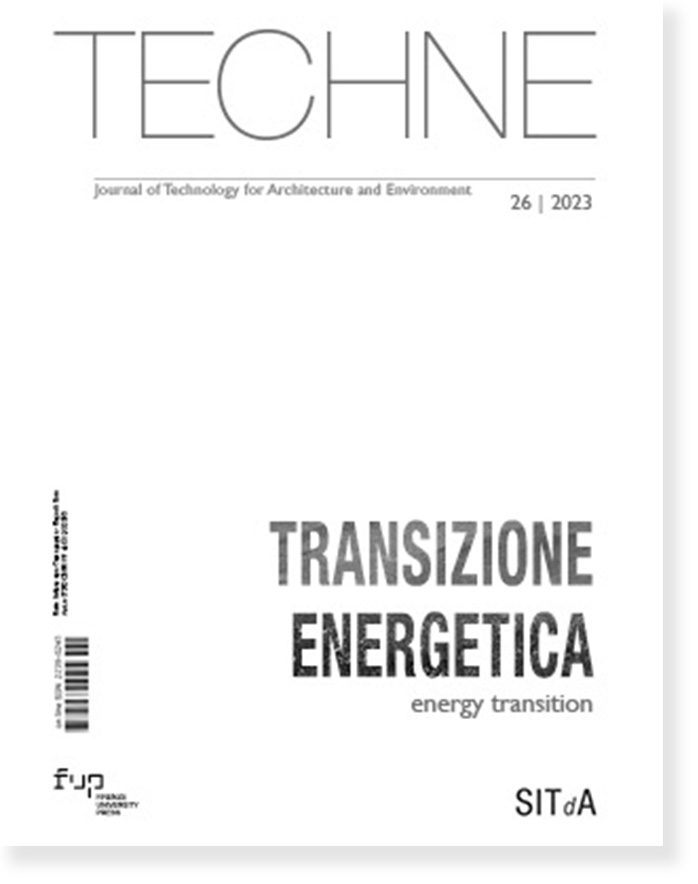Published 2023-10-31
Keywords
- Social integration,
- Renewable communities,
- Energy transition,
- Technological design,
- Green technologies
How to Cite
Copyright (c) 2023 Antonio Basti, Monica Misceo, Elena Di Giuseppe

This work is licensed under a Creative Commons Attribution 4.0 International License.
Abstract
The text looks at Renewable Energy Communities (RECs) as a tool for implementing strategies that favour local energy transition, with particular focus on inland areas and small historical settlements. These “sensitive” contexts, often situated in landscapes or historical-cultural areas of significant value, require policies to convert to green energy and energy self-sufficiency that evaluate the need for specific actions tied to environmental protection objectives. The study reveals the role RECs can play in urban and landscape regeneration processes in these territories, under the condition that we adopt a holistic and multidisciplinary approach to design, oriented toward reimagining these sites with a view toward relaunching and promoting them.
Downloads
References
Alagirisamy, B. & Ramesh, P. (2022). Smart sustainable cities: Principles and future trends. Sustainable Cities and Resilience: Select Proceedings of VCDRR 2021, 301-316.
Barroco F., Cappellaro F. & Palumbo C. (2000) (a cura di), Le comunità energetiche in Italia, Una Guida per Orientare i Cittadini nel Nuovo Mercato Dell’energia, available at: https://iris.enea.it/retrieve/dd11e37c-eaac-5d97-e053-d805fe0a6f04/Guida_Comunita-energetiche.pdf (accessed on 25/02/ 2023)
Borràs, I. M., Neves, D. & Gomes, R. (2023), Using urban building energy modeling data to assess energy communities potential, Energy and Buildings, 112791, 2023,Elsevier,
De Lotto, R., Moroni S. & De Franco, A. (2023), "Energy communities in smart urban ecosystem. Institutional, organisational, phycological, technological issues" in Sokołowski M. M. & Visvizi A., Editors, Routledge Handbook of Energy Communities and Smart Cities, 2023, Routledge, 2023, Taylor and Francis
De Pascali P. (2008), Città ed Energia. La valenza energetica dell’organizzazione insediativa, Franco Angeli, Milano.
De Vidovich L., Tricarico, L. & Zulianello M. (2001), Community Energy Map. Una ricognizione delle prime esperienze di comunità energetiche rinnovabili, Franco Angeli, available at: https://iris.luiss.it/retrieve/e163de42-e19f-19c7-e053-6605fe0a8397/740-99Z_Book%20Manuscript-4397-1-10-20211213.pdf (accessed on 25/02/2023)
European Commission (2011), COMM (2011) 885, Communication from the Commission to the European Parliament, the Council, the European economic and social committee and the committee of the regions, energy roadmap 2050, Bruxelles
European Commission (2016), Urban Agenda for the EU, available at: https://ec.europa.eu/futurium/en/urban-agenda-eu/what-urban-agenda-eu.html (accessed on 01/03/2023).
European Commission (2019), Clean energy for all Europeans package, available at: https://energy.ec.europa.eu/topics/energy-strategy/clean-energy-all-europeanspackage_en (accessed on 01/03/2023).
Gerundo, R., Marra, A. & Grimaldi, M. (2022), “A Preliminary Model for promoting Energy Communities in Urban Planning”, International Symposium on New Metropolitan Perspectives: Post COVID Dynamics: Green and Digital Transition between Metropolitan and Return to Villages Perspectives, 2833-2840, 2022, Springer
Ginelli, E. & Daglio, L. (2016). “Le infrastrutture per le energie rinnovabili nel paesaggio. Strumenti di progetto e traiettorie dell’innovazione.-Infrastructures for renewable energies in landscape. Design tools and innovation trends”, Techne, 11, 2016, 119-126.
Hamann, K. RS; Bertel, M.P.; Ryszawska, B.; Lurger, B.; Szymański, P.; Rozwadowska, M.; Goedkoop, F.; Jans, L.; Perlaviciute, G. & Masson, T. (2023), "An interdisciplinary understanding of energy citizenship: Integrating psychological, legal, and economic perspectives on a citizen-centred sustainable energy transition",Energy Research & Social Science,97, 102959, Elsevier
Owens, S. 1986. Energy, Planning and Urban Form, Pion Limited, 207 Brondesbury Parck, London NW2 5JN
Parlamento e Consiglio Europeo (2018), Direttiva (Ue) 2018/2001 sulla promozione dell'uso dell'energia da fonti rinnovabili, Bruxelles
Parlamento e Consiglio Europeo (2019), Direttiva (Ue) 2019/944 relativa a norme comuni per il mercato interno dell'energia elettrica che modifica la direttiva 2012/27/UE, Bruxelles
Ramirez-Cobo, I., ; Debizet, G. & Tribout, S., (2022), “Anticipating energy communities in urban projects: Challenges and limits”, Local Energy Communities, 87-104, 2022, Routledg
Rossetto, N. (2022), Le comunità di energia rinnovabile per una transizione energetica più partecipata e sostenibile, Il Mulino.






